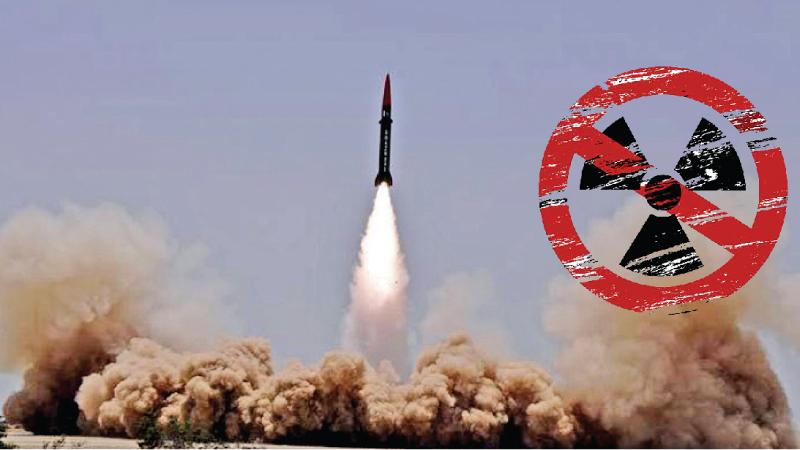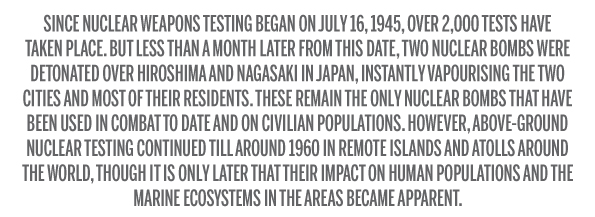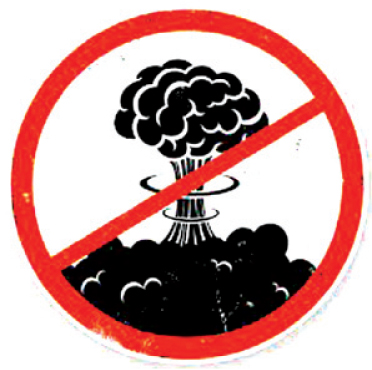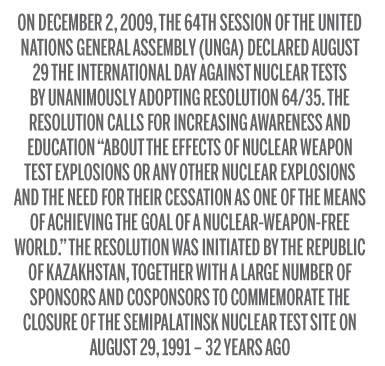
There are enough (around 13,800) nuclear weapons stockpiled by various countries which can destroy the world many times over, though only around 3,750 of these are tactically active. That is still too many though and even 200 high-powered nuclear weapons should be able to blow the entire planet to smithereens. It is now commonly believed that there will be no winners in a nuclear war, because nearly all of humankind could perish. Hence the tacit understanding among the nuclear-armed States that a nuclear war should never be fought in the first place.
 “I know not with what weapons World War III will be fought, but World War IV will be fought with sticks and stones,” said Albert Einstein, implying that civilisation as we know it could come to an untimely end after a nuclear war. The late US President John F. Kennedy once warned that “every man, woman, and child lives under a nuclear sword of Damocles, hanging by the slenderest of threads, capable of being cut at any moment.”
“I know not with what weapons World War III will be fought, but World War IV will be fought with sticks and stones,” said Albert Einstein, implying that civilisation as we know it could come to an untimely end after a nuclear war. The late US President John F. Kennedy once warned that “every man, woman, and child lives under a nuclear sword of Damocles, hanging by the slenderest of threads, capable of being cut at any moment.”
Risky utopian dream at worst
The last President of the USSR Mikhail Gorbachev, in an opinion piece wrote: “Critics present nuclear disarmament as unrealistic at best, a risky utopian dream at worst. They point to the Cold War’s “long peace” as proof that nuclear deterrence is the only means of staving off a major war. As someone who has commanded these weapons, I strongly disagree. Nuclear deterrence has always been a hard and brittle guarantor of peace. By failing to propose a compelling plan for nuclear disarmament, the US, Russia and the other nuclear powers are promoting a future in which nuclear weapons will inevitably be used. That catastrophe must be forestalled.”
 But even with this knowledge, nuclear weapons are still being developed or tested. In addition to the five declared Nuclear Powers (UK, USA, China, Russia and France), several other countries including India, Pakistan, Israel and North Korea are known to possess nuclear weapons despite the existence of the Nuclear Non-Proliferation Treaty (NPT) which prohibits other countries from developing or accessing them.
But even with this knowledge, nuclear weapons are still being developed or tested. In addition to the five declared Nuclear Powers (UK, USA, China, Russia and France), several other countries including India, Pakistan, Israel and North Korea are known to possess nuclear weapons despite the existence of the Nuclear Non-Proliferation Treaty (NPT) which prohibits other countries from developing or accessing them.
There are moves underway to prevent Iran from developing a nuclear weapon, though the latter maintains that its nuclear programme is only for peaceful civilian purposes. Moreover, some third party countries host nuclear weapons from the five declared nuclear powers. North Korea is believed to have tested a nuclear weapon in an underground site rather recently.
Devastating effects
Since nuclear weapons testing began on July 16, 1945, over 2,000 tests have taken place. But less than a month later from this date, two nuclear bombs were detonated over Hiroshima and Nagasaki in Japan, instantly vapourising the two cities and most of their residents. These remain the only nuclear bombs that have been used in combat to date and on civilian populations. However, above-ground nuclear testing continued till around 1960 in remote islands and atolls around the world, though it is only later that their impact on human populations and the marine ecosystems in the respective areas became apparent.
In fact, in the early days of nuclear testing little consideration was given to its devastating effects on human life, let alone the dangers of nuclear fallout from atmospheric tests. Hindsight and history have shown the terrifying and tragic effects of nuclear weapons testing, especially when controlled conditions are deliberately or unwittingly ignored, in the light of the far more powerful and destructive nuclear weapons that exist today.
And it is not only nations who could have access to weapons – terrorist groups or even organised crime groups may get hold of and try to use chemical, biological and worse, nuclear weapons as depicted in many Hollywood movies. But it could happen in real life too and would be an unimaginable nightmare.
A nuclear-weapon-free world
On December 2, 2009, the 64th session of the United Nations General Assembly (UNGA) declared August 29 the International Day against Nuclear Tests by unanimously adopting resolution 64/35. The resolution calls for increasing awareness and education “about the effects of nuclear weapon test explosions or any other nuclear explosions and the need for their cessation as one of the means of achieving the goal of a nuclear-weapon-free world.”
 The Resolution was initiated by the Republic of Kazakhstan, together with a large number of sponsors and cosponsors to commemorate the closure of the Semipalatinsk Nuclear Test site on August 29, 1991 – 32 years ago.
The Resolution was initiated by the Republic of Kazakhstan, together with a large number of sponsors and cosponsors to commemorate the closure of the Semipalatinsk Nuclear Test site on August 29, 1991 – 32 years ago.
The year 2010 marked the inaugural commemoration of the International Day against Nuclear Tests. In each subsequent year, the day has been observed by coordinating various activities throughout the world, such as symposia, conferences, exhibits, competitions, publications, lectures, media broadcasts and other initiatives.
Since its establishment, many bilateral and multilateral governmental level developments as well as broad movements in civil society have helped to advance the cause of banning nuclear tests.
International efforts
Moreover, “Convinced that nuclear disarmament and the total elimination of nuclear weapons are the only absolute guarantee against the use or threat of nuclear weapons,” the General Assembly designated September 26 as the “International Day for the Total Elimination of Nuclear Weapons”, which is devoted to furthering the objective of the total elimination of nuclear weapons, through the mobilisation of international efforts.
The International Day for the Total Elimination of Nuclear Weapons was observed for the first time in September 2014. The International Day against Nuclear Tests, together with other events and actions, has fostered a global environment that strongly advocates for a world free of nuclear weapons.
The international instrument to put an end to all forms of nuclear testing is the 1996 Comprehensive Nuclear-Test-Ban Treaty (CTBT). Unfortunately, this has yet to enter into force.
As the UN Secretary-General recognized in his disarmament agenda “Securing our Common Future” launched on 24 May 2018, the norm against testing is an example of a measure that serves both disarmament and non-proliferation objectives. By constraining the development of advanced new types of nuclear weapons, the CTBT puts a brake on the arms race. It also serves as a powerful barrier against any States that might seek to develop, manufacture and subsequently acquire nuclear weapons in violation of their non-proliferation commitments.
All countries must make efforts to ensure the entry into force of the CTBT and to preserve its place in the international architecture. The UN Secretary-General has appealed to all remaining States whose ratifications are required for the CTBT to enter into force to commit to sign the Treaty at an early date and to accelerate the completion of their ratification processes.
It was adopted by the United Nations General Assembly on September 10, 1996. To date, 185 countries have signed the treaty and 170 have ratified it. For the Treaty to enter into Force, it must be ratified by those States with significant nuclear capabilities.
It is the hope of the UN and indeed, all peace loving citizens that one day all nuclear weapons will be eliminated. Until then, there is a need to observe International Day against Nuclear Tests.
While the general consensus within the international community is that nuclear weapons tests pose life-threatening risks, there still exists to some degree a lingering suspicion of the possibility of clandestine nuclear weapons testing. There is also a concern that if nuclear weapons cannot be tested their reliability may be in jeopardy. However, over the years, advances in science and technology have exponentially boosted the capacity to monitor and verify compliance mechanisms and nuclear weapons proliferation detection.
Nothing can play as crucial a role in avoiding a nuclear war or nuclear terrorist threat as the total elimination of nuclear weapons. Bringing an irreversible end to nuclear explosions – even those used for testing - will prevent the further development of nuclear weapons.
Major incidents
But nuclear power – in the other sense of the term – that of energy – can also sometimes prove to be dangerous. Three major incidents come to mind – Three Mile Island (USA, 1979), Chernobyl (Ukraine, 1986) and Fukushima (Japan, 2011). Some of these areas are still off-limits after all these years due to radiation fears. Right now, concerns have been raised over the safety and fate of the Zaporizhzhia nuclear power plant in Ukraine, one of the world’s largest, as the nearby areas have been hit by shelling in the Russia-Ukraine War.
 The International Atomic Energy Agency (IAEA) has warned of grave consequences if the facility is hit and called on both sides to let it be made a formal demilitarized zone. However, one has to accept that there are peaceful and legitimate uses of nuclear power and all countries have the right to access such technology. But this should be done under tightly controlled conditions under IAEA supervision. Sri Lanka too has taken preliminary steps in this regard.
The International Atomic Energy Agency (IAEA) has warned of grave consequences if the facility is hit and called on both sides to let it be made a formal demilitarized zone. However, one has to accept that there are peaceful and legitimate uses of nuclear power and all countries have the right to access such technology. But this should be done under tightly controlled conditions under IAEA supervision. Sri Lanka too has taken preliminary steps in this regard.
Another perspective on the weapons race is that if the superpowers and other powerful nations cut their defence spending even by a fraction, there will be enough funds to address most of the problems faced by developing nations. A weapon-free world, especially a nuclear weapon-free world, is thus an ideal ingredient for world peace and harmony.
In fact, the biggest reason for cutting down on the nuclear and other weapons is the sheer expenditure on arms. The total world expenditure on major armaments in 2021 was estimated at US$ 2,113 Billion (Stockholm International Peace Research Institute). Just imagine what could be done to build a better world with these enormous resources now spent on defence. From schooling for all the world’s children to better drinking water for around one-third of the world’s population, nothing will be out of reach. That is the kind of race we can be proud of, not a race where everyone on the planet dies in the end.
